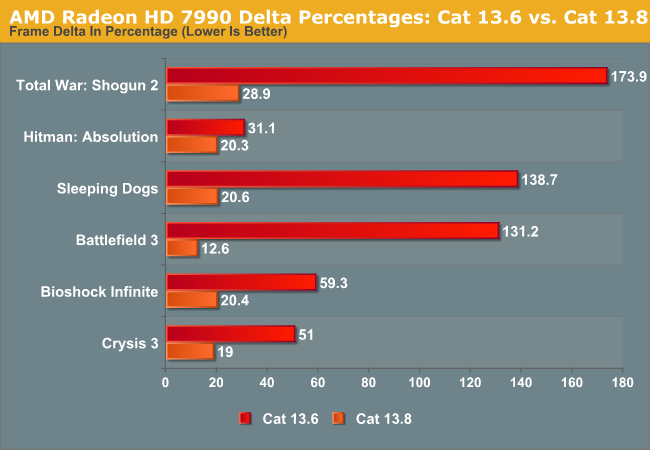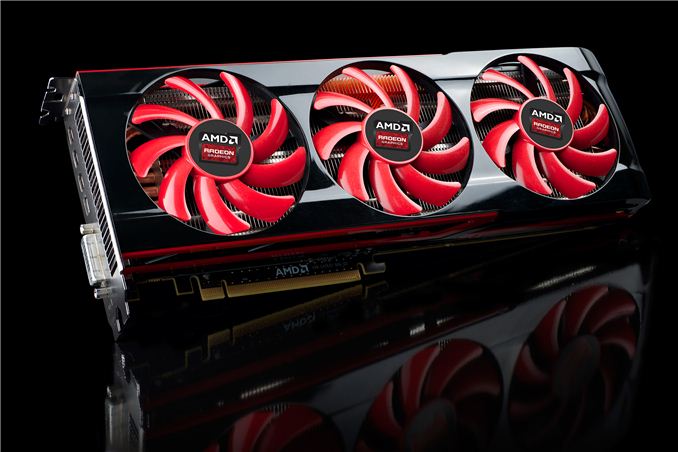AMD Frame Pacing Explored: Catalyst 13.8 Brings Consistency to Crossfire
by Ryan Smith on August 1, 2013 2:00 PM ESTFinal Words
Bringing things to a close, today’s driver release isn’t about any grand revelations for AMD, but rather about AMD following through on their plans and commitments to improve frame time consistency on their products. We’ve seen AMD get their house in order with respect to single-GPU cards earlier this year, and now the same is starting to happen for multi-GPU setups.
To be clear here AMD’s initial situation should never have happened. AMD should have been doing the appropriate competitive analysis from the start, never letting themselves fall behind like this. But we aren’t in the business of berating companies that make an honest effort to improve their products like AMD is doing, so while AMD could have done better in the past they are finally making the right moves in the present, and it’s the present that’s going to be the most important for AMD’s customers.
So what does AMD’s present look like? Quite frankly, it looks a lot better than it did yesterday. AMD set out to greatly improve on their frame pacing situation on their Crossfire setups and they have delivered just that. With just one driver revision we have seen the Radeon HD 7990’s frame pacing go from laughable to acceptable; delta percentages of over 100% have been reduced to 20% or lower in 5 of the 6 games we’ve tested. For those sensitive to micro-stutter and other matters of consistency the difference is at times going to be staggering. At the most basic level, AMD has achieved their objectives.
With that said, there’s still room for improvement, and this goes for both functionality and further improvements in frame consistency. AMD’s triage-like approach means that D3D9, OpenGL, and most importantly Eyefinity are still not capable of using frame metering. These will be covered in future phases of AMD’s rollout of their frame pacing technology, and they can’t come soon enough, but for the time being these are limitations that need to be kept in mind.

Similarly while AMD’s frame pacing has improved to the point where we find it acceptable, 20% deltas are still generally twice that of NVIDIA’s GeForce GTX 690, never mind the extreme consistency single-GPU setups offer. We never realistically expected AMD to match NVIDIA’s frame interval consistency overnight, but in time it would be nice to see them get close, and for both parties to further improve beyond that.
Moving on, while today’s driver release is primarily one part of AMD’s longer term plan to deal with frame interval consistency, AMD is trying hard to also use this moment as something of a second launch for the Radeon HD 7990. With the 7990 launching in April it had the poor timing of arriving shortly after the multi-GPU frame pacing issue came to a head, which is something that has hobbled the card since its launch. In terms of absolute performance (average frame rates) things have changed very little since the launch of the 7990 so we’re not going to get into the matter of performance.
What has changed since then for the 7990 is first and foremost its frame pacing improvements as we’ve seen today. To be very clear here the GTX 690 is still the better card for those users heavily concerned about consistency, but AMD’s improvements have brought the 7990 to the point where we find its frame consistency generally acceptable. This isn’t a rousing recommendation nor is it meant to be, but it’s a reflection of the fact that AMD has brought their consistency to the point where pairing up multiple Tahiti GPUs as is done in the 7990 is no longer fraught with the frame pacing problems it once was. For most users I believe we’re to the point where the consistency differences are greater on paper than they are on the eyes, but of course that is going to depend on the visual acuity of the user.

Moving on, the other thing that has changed for AMD is pricing and competitive positioning. Officially AMD hasn’t cut the price on the 7990, but the fact that XFX is now offering a reference 7990 for $799 after rebate is not a coincidence. With AMD’s Level Up with Never Settle Reloaded promotion still running, AMD is making a clear play for the value segment right now. I don’t believe it’s where AMD would like to be, but there’s no arguing that it’s effective. For users who have a reasonable level of faith in Crossfire scaling and are satisfied with AMD’s frame pacing improvements, a $799 7990 is a very good deal at the moment.
With that in mind, we do want to reiterate that our editorial position here on AFR setups isn’t changing. We still favor strong single-GPU setups over weaker multi-GPU setups, but this is a matter of valuing the lack of AFR profile requirements, coupled with the tendency for newly launched games to have immature AFR profiling, and of course the general consistency issues we’ve covered today. AFR is still the only way to further improve performance once the single-GPU route has been exhausted, and in AMD’s case it’s the only way to exceed the performance of a 7970 GHz Edition, so it does have its place.
Ultimately we have to give AMD the kudos they deserve. They have come forward about their issues, set out a plan to fix them, and have begun delivering on those plans. There’s still room for further improvement within AMD’s drivers, so AMD’s job is far from done, but today they have taken the first step needed to settle the frame pacing problems that have been dogging their products.










102 Comments
View All Comments
chizow - Saturday, August 3, 2013 - link
Written on the walls at AMD Driver HQ I'm sure, quickly referenced when questioned about microstutter being worst on CF.krutou - Friday, August 2, 2013 - link
BUT, BUT, BUT, RADEON PRO?!?LordOfTheBoired - Saturday, August 3, 2013 - link
Took them by the hand? Looks more to me like "waited until people cared, then released a benchmark to prove they didn't have the problem, while offering no constructive commentary."And the hell of it is... AMD's stance makes sense. This IS a market that hates VSync because ZOMG LAG. "The market" has made it ABUNDANTLY clear that they have no interest whatsoever in technologies that improve the visual experience at the (real or imagined) cost of responsiveness.
But apparently that's only true when there's the visual equivalent of a record skip on your screen and not when it's a subtle frame rate fluctuation. The former is a good thing because it means you "aren't lagged", the latter is a horrible thing because it means you "aren't lagged".
chizow - Wednesday, August 7, 2013 - link
@LordOfTheBoired - this is the type of indignant attitude that got AMD and their fans in this predicament to begin with.mikato - Wednesday, August 7, 2013 - link
Well one result of Nvidia releasing the software was to allow tech journalists to shine a bright spotlight on a problem of their competitor's products. Your "holding AMD by the hand" idea is pretty amusing.novastar78 - Wednesday, August 7, 2013 - link
What's sad is that AMD has ripped ATi to shreds to the point where they are spread pretty thin. Just getting a working product out the door is a task. You are being waaay too hard on them.They were using traditional methods to test and frankly it's not so unimaginable that they were caught by this. Granted, maybe it should have been caught sooner, but to demonize them or put them down for it seems a bit harsh.
They know now that it's a big problem are definitely committed to fixing it. You can clearly see that they are trying to stabilize the company and there is lots of turmoil. The moves they are making and the people being brought on board are a good sign. There is definitely a process change that needs to happen but when the tree is being shaken so many times too many apples can fall.
Give it some time, I think we will see great things form them over the next few years.
Wreckage - Thursday, August 1, 2013 - link
It did not help that certain people were claiming that AMD does not have a stutter problem.DanNeely - Thursday, August 1, 2013 - link
The problem is that AMD didn't think they had a stutter problem; or more precisely, until 3rd parties shoved the reality in their face they assumed (without testing) that they and nVidia had equal amounts of the problem.I suspect at one point in the past they were right; and that the genesis of nVidia's "years in the making" tool to measure the problem dates back to when they discovered it was a problem internally and began working on fixes so that they could announce the same tool at the same time that their drivers had a negligible impact from it. It'd be interesting to see what would happen if someone tested SLI card/driver configurations from a few years ago to see how well nVidia did at the time.
BrightCandle - Friday, August 2, 2013 - link
NVidia has had this fixed for a lot longer than that. The 680's were noticeably smoother on their release day compared to the 7970 crossfire. NVidia has claimed they have been fixing this since the 8800 and there is no reason not to believe them as HardOCP and other review sites have been noting the difference for years.HisDivineOrder - Friday, August 2, 2013 - link
Exactly. This has been a problem for as long as there has been Crossfire. I think a lot of people are so shocked by this fact (because some of them owned Crossfire and just dealt with it and didn't realize they were getting shafted) they can't accept it.Yes, you got reamed. Yes, for years, you were using Crossfire and suffering from microstutter when you needn't have to. Yes, AMD took you for a ride. It's so infuriating it drives people not to want to believe it because to believe it would be so horrible as to suddenly be intolerable.
Do what most people do. Just stick with nVidia since you know they do proper testing. Boycott AMD for a five year period and come back once you're sure AMD's got their act together.